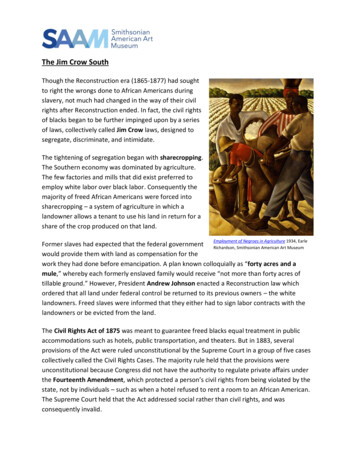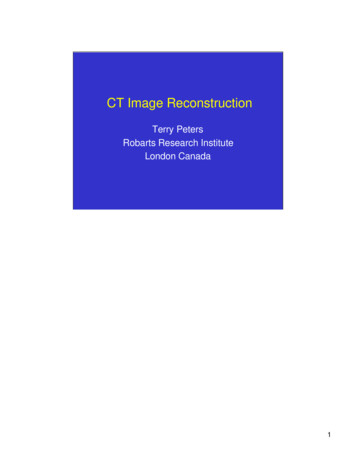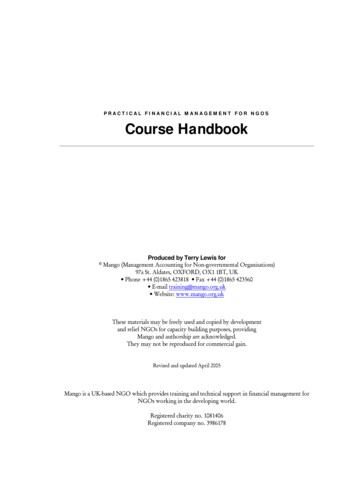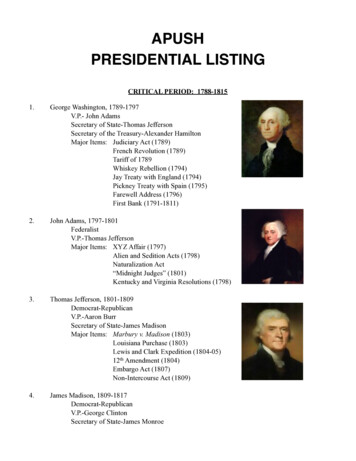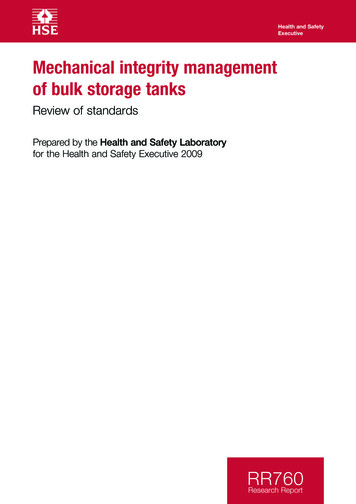
Transcription
CHAPTER161865–1877ReconstructionCalifornia StandardsHistory–Social Science8.10 Students analyze the multiple causes, key events, and complexconsequences of the Civil War.8.11 Students analyze the character and lasting consequences ofReconstruction.Analysis SkillsHR 3 Students distinguish relevant from irrelevant information.HI 4 Students recognize the role of chance, oversight, and error inhistory.English–Language ArtsWriting 8.2.5 Write documents related to career development.Reading 8.2.0 Students read and understand grade-level apporpriatematerial.FOCUS ON WRITINGJob History When the Civil War ended, it was time torebuild. People were ready to get back to work. But life hadchanged for many people and would continue to change.As you read this chapter, think about jobs people may havehad during Reconstruction.1865Abraham Lincolnis assassinated.18651865Black Jamaicans rebelagainst the wealthyplanter class.508CHAPTER 16
HOLTHistory’s Impact video seriesWatch the video to understand the impact of thepreservation of the Union.What You Will Learn The ruins of this Virginia plantation stand as ableak reminder of the changes brought to theSouth by the Civil War. In this chapter you willlearn about the challenges that faced the nationafter the Civil War and attempts to meet thosechallenges.18681870President AndrewJohnson isimpeached andalmost removedfrom office.Hiram Revelsbecomes the firstAfrican Americanto serve in theU.S. Senate.18701877The Compromise of 1877ends Reconstruction.1875186818691871The Meiji dynastyreturns to powerin Japan.The Suez Canal opens,linking the Mediterraneanand Red seas.Otto von Bismarck andWilhelm I unite Germany.1880RECONSTRUCTION509
Reading Social StudiesEconomicsGeographyReligionPoliticsFocus on Themes In this chapter, you will readabout the time immediately after the Civil War. Youwill see how the government tried to help the Southrebuild itself and will learn about how life changedfor African Americans after slavery was declaredby Kylene BeersSocietyand CultureScience andTechnologyillegal. You will read about the political conflictsthat emerged as southern leadership worked to gaincontrol of Reconstruction efforts. Throughout thechapter, you will read how the culture of the Southchanged after the War.Analyzing Historical InformationFocus on ReadingHistory books are full ofinformation. As you read, you are confronted withnames, dates, places, terms, and descriptions onevery page. You don’t want to have to deal withanything unimportant or untrue.Identifying Relevant and Essential InformationInformation in a history book should be relevant tothe topic you’re studying. It should also be essentialto understanding that topic and verifiable. Anythingelse distracts from the material you are studying.The first passage below includes several pieces ofirrelevant and nonessential information. In the second, this information has been removed. Note howmuch easier the revised passage is to comprehend.First PassagePresident Abraham Lincoln, who wasvery tall, wanted to reunite the nationas quickly and painlessly as possible.He had proposed a plan for readmitting the southern states even beforethe war ended, which happened on aSunday. Called the Ten Percent Plan,it offered southerners amnesty, or official pardon, for all illegal acts supporting the rebellion. Today a group calledAmnesty International works to protectthe rights of prisoners. Lincoln’s plancertainly would have worked if it wouldhave been implemented.510CHAPTER 1600Revised PassageLincoln’sappearanceand the day onwhich the warended are notessential facts.AmnestyInternational isnot relevant tothis topic.There is noway to provethe accuracyof the lastsentence.President Abraham Lincoln wantedto reunite the nation as quickly andpainlessly as possible. He had proposed a plan for readmitting thesouthern states even before the warended. Called the Ten Percent Plan,it offered southerners amnesty, orofficial pardon, for all illegal acts supporting the rebellion.From Chapter 16, p. 513Additional readingsupport can befound in the
ELA Analysis HI 3 Distinguish relevant, essential, and verifiable information.HSS Reading 8.2.0 Students read and understand grade-level-appropriate material.Key Termsand PeopleYou Try It!Chapter 16The following passage is adapted from the chapter you are aboutto read. As you read, look for irrelevant, nonessential, or unverifiableinformation.Reconstruction (p. 512)Ten Percent Plan (p. 513)Thirteenth Amendment (p. 514)Freedmen’s Bureau (p. 516)Andrew Johnson (p. 517)Section 1The Freedmen’s BureauSection 2In 1865 Congress established the Freedmen’s Bureau, an agency providing relief notonly for freedpeople and certain poor people, but white refugees as well. The Bureauhad a difficult job. It may have been one ofthe most difficult jobs ever. At its high point,about 900 agents served the entire South.All 900 people could fit into one hotel ballroom today. Bureau commissioner OliverO. Howard eventually decided to use theBureau’s limited budget to distribute food tothe poor and to provide education and legalhelp for freedpeople. One common food inthe South at that time was salted meat. TheBureau also helped African American warveterans. Today the Department of Veterans’Affairs assists American war veterans.FromChapter 16,p. 516After you read the passage, answer the following questions.1. Which sentence in this passage is unverifiable and should be cut?2. Find two sentences in this passage that are irrelevant to the dis-Black Codes (p. 518)Radical Republicans (p. 519)Civil Rights Act of 1866 (p. 520)Fourteenth Amendment (p. 521)Reconstruction Acts (p. 521)impeachment (p. 522)Fifteenth Amendment (p. 523)Section 3Hiram Revels (p. 525)Ku Klux Klan (p. 526)Compromise of 1877 (p. 527)poll tax (p. 528)segregation (p. 528)Jim Crow laws (p. 528)Plessy v. Ferguson (p. 529)sharecropping (p. 529)Academic VocabularySuccess in school is related toknowing academic vocabulary—the words that are frequently usedin school assignments and discussions. In this chapter, you will learnthe following academic words:procedure (p. 513)principle (p. 520)cussion of the Freedmen’s Bureau. What makes those sentencesirrelevant?3. Look at the last sentence of the passage. Do you think this sentence is essential to the discussion? Why or why not?As you read Chapter 16, ask yourselfwhat makes the information youare reading essential to a study ofReconstruction.RECONSTRUCTIONSECTION TITLE511
SECTION1What You Will Learn Main Ideas1. President Lincoln andCongress differed in theirviews as Reconstructionbegan.2. The end of the Civil Warmeant freedom for AfricanAmericans in the South.3. President Johnson’s planbegan the process ofReconstruction.Rebuildingthe SouthIf YOU were there.You are a young soldier who has been fighting in the Civil Warfor many months. Now that the war is over, you are on your wayhome. During your journey, you pass plantation manor homes,houses, and barns that have been burned down. No one is doingspring planting in the fields. As you near your family’s farm, yousee that fences and sheds have been destroyed.What would you think your future onthe farm would be like?The Big IdeaThe nation faced many problemsin rebuilding the Union.BUILDING BACKGROUND When the Civil War ended, much ofKey Terms and PeopleReconstruction, p. 512Ten Percent Plan, p. 513Thirteenth Amendment, p. 514Freedmen’s Bureau, p. 516Andrew Johnson, p. 517the South lay in ruins. Like the young soldier above, many people returned to destroyed homes and farms. Harvests of corn, cotton, rice,and other crops fell far below normal. Many farm animals had beenkilled or were roaming free. These were some of the challenges inrestoring the nation.Reconstruction BeginsHSS 8.10.7 Explain how the waraffected combatants, civilians, thephysical environment, and futurewarfare.8.11.1 List the original aims of Reconstruction and describe its effects onthe political and social structures ofdifferent regions.8.11.3 Understand the effects of theFreedmen’s Bureau and the restrictions placed on the rights and opportunities of freedmen, including racialsegregation and “Jim Crow” laws.8.11.5 Understand the Thirteenth,Fourteenth, and Fifteenth Amendments to the Constitution and analyzetheir connection to Reconstruction.512CHAPTER 16After the Civil War ended in 1865, the U.S. government facedthe problem of dealing with the defeated southern states. TheReconstruction,, the process ofnation dealt with the challenges of Reconstructionreadmitting the former Confederate states to the Union. It lastedfrom 1865 to 1877.
Damaged SouthTired southern soldiers returned home to findthat the world they had known before the warwas gone. Cities, towns, and farms had beenruined. Because of high food prices and widespread crop failures, many southerners facedstarvation. The Confederate money held bymost southerners was now worthless. Banksfailed, and merchants had gone bankruptbecause people could not pay their debts.Former Confederate general BraxtonBragg was one of many southerners whofaced economic hardship. He found that“all, all was lost, except my debts.” In SouthCarolina, Mary Boykin Chesnut wrote in herdiary about the isolation she experiencedafter the war. “We are shut in here. . . . AllRR’s [railroads] destroyed—bridges gone. Weare cut off from the world.”Lincoln’s PlanPresident Abraham Lincoln wanted to reunitethe nation as quickly and painlessly as possible. He had proposed a plan for readmittingthe southern states even before the war ended.Called the Ten Percent Plan , it offered southerners amnesty, or officialofficial pardon, for all illegal acts supporting the rebellion. To receiveamnesty, southerners had to do two things.They had to swear an oath of loyalty to theUnited States. They also had to agree that slavery was illegal. Once 10 percent of voters ina state made these pledges, they could forma new government. The state then could bereadmitted to the Union.Louisiana quickly elected a new state legislature under the Ten Percent Plan. Othersouthern states that had been occupied byUnion troops soon followed Louisiana backinto the United States.Wade-Davis BillSome politicians argued that Congress, notthe president, should control the southernstates’ return to the Union. They believedthat Congress had the power to admit newstates. Also, many Republican members ofCongress thought the Ten Percent Plan didnot go far enough. A senator from Michiganexpressed their views.“The people of the North are not such fools as to . . .turn around and say to the traitors, ‘all you haveto do [to return] is . . . take an oath that henceforthyou will be true to the Government.’”–Senator Jacob Howard, quoted in Reconstruction:America’s Unfinished Revolution, 1863–1877, by Eric FonerTwo Republicans—Senator BenjaminWade and Representative Henry Davis—hadan alternative to Lincoln’s plan. Under theprocedure of the Wade-Davis bill, a state hadto meet two conditions before it could rejointhe Union. First, it had to ban slavery. Second, a majority of adult males in the statehad to take the loyalty oath.ACADEMICVOCABULARYprocedurea series of stepstaken to accomplish a taskWar destroyed Richmond, Virginia, oncethe proud capital of the Confederacy.RECONSTRUCTION513
Testing New FreedomsUnder the Wade-Davis bill, only southerners who swore that they had never supported the Confederacy could vote or holdoffice. In general, the bill was much stricterthan the Ten Percent Plan. Its provisionswould make it harder for southern states torejoin the Union quickly.President Lincoln therefore refusedto sign the bill into law. He thought thatfew southern states would agree to meetits requirements. He believed that his planwould help restore order more quickly.READING CHECK Contrasting How wasthe Ten Percent Plan different from the WadeDavis Bill?514CHAPTER 16Freedom for AfricanAmericansOne thing Republicans agreed on was abolishing slavery. The Emancipation Proclamation had freed slaves only in areas that hadnot been occupied by Union forces, not inthe border states. Many people feared thatthe federal courts might someday declare itunconstitutional.Slavery EndsOn January 31, 1865, at President Lincoln’surging, Congress proposed the ThirteenthAmendment. This amendment made slavery illegal throughout the United States.
The freedpeople at left have packedtheir household belongings and areleaving Richmond. Many people traveled in search of relatives. Othersplaced newspaper advertisementslooking for long-lost relatives. Forother freedpeople, like the coupleabove, freedom brought the right tomarry.In what ways did former slaves reactto freedom?earlier. Others placed newspaper ads seekinginformation about their children. Many womenbegan to work at home instead of in the fields.Still others adopted children of dead relativesto keep families together. Church membersestablished voluntary associations and mutualaid societies to help those in need.Now that they could travel without apass, many freedpeople moved from mostlywhite counties to places with more AfricanAmericans. Other freedpeople traveled simply to test their new freedom of movement.A South Carolina woman explained thisneed. “I must go, if I stay here I’ll never knowI’m free.”For most former slaves, freedom totravel was just the first step on a long roadtoward equal rights and new ways of life.Adults took new last names and began toinsist on being called Mr. or Mrs. as a signof respect, rather than by their first namesor by nicknames. Freedpeople began todemand the same economic and politicalrights as white citizens. Henry Adams, a former slave, argued that “if I cannot do like awhite man I am not free.”Forty Acres to Farm?The amendment was ratified and took effecton December 18, 1865. When abolitionistWilliam Lloyd Garrison heard the news, hedeclared that his work was now finished.He called for the American Anti-SlaverySociety to break up. Not all abolitionistsagreed that their work was done, however.Frederick Douglass insisted that “slavery isnot abolished until the black man has theballot [vote].”Freedom brought important changesto newly freed slaves. Many couples heldceremonies to legalize marriages that hadnot been recognized under slavery. Manyfreedpeople searched for relatives who hadbeen sold away from their families yearsMany former slaves wanted their own landto farm. Near the end of the Civil War,Union general William Tecumseh Shermanhad issued an order to break up plantationsin coastal South Carolina and Georgia. Hewanted to divide the land into 40-acre plotsand give them to former slaves as compensation for their forced labor before the war.Many white planters refused to surrender their land. Some freedpeople pointed outthat it was only fair that they receive someof this land because their labor had madethe plantations prosper. In the end, the U.S.government returned the land to its originalowners. At this time, many freedpeople wereunsure about where they would live, whatkind of work they would do, and what rightsthey had. Many freedoms that were theirs bylaw were difficult to enforce.RECONSTRUCTION515
Freedmen’s Bureauknowledge, and such a capacity for attaining[reaching] it.”After the war, some freedpeople organizedtheir own education efforts. For example, Freedmen’s Bureau agents found that some AfricanAmericans had opened schools in abandonedbuildings. Many white southerners continued to believe that African Americans shouldnot be educated. Despite opposition, by 1869more than 150,000 African American studentswere attending more than 3,000 schools. TheFreedmen’s Bureau also helped establish several universities for African Americans, includingHoward and Fisk universities.Students quickly filled the new classrooms. Working adults attended classes in theevening. African Americans hoped that education would help them to understand andprotect their rights and to enable them to findbetter jobs. Both black and white southernersbenefited from the effort to provide greateraccess to education in the South.In 1865 Congress established the Freedmen’sBureau , an agency providing relief not onlyfor freedpeople and certain poor people, butwhite refugees as well. The Bureau had adifficult job. At its high point, about 900agents served the entire South. Bureaucommissioner Oliver O. Howard eventually decided to use the Bureau’s limitedbudget to distribute food to the poor and toprovide education and legal help for freedpeople. The Bureau also helped African American war veterans.The Freedmen’s Bureau played an important role in establishing more schools in theSouth. Laws against educating slaves meantthat most freedpeople had never learned toread or write. Before the war ended, however,northern groups, such as the American Missionary Association, began providing booksand teachers to African Americans. Theteachers were mostly women who were committed to helping freedpeople. One teachersaid of her students, “I never before saw children so eager to learn. . . . It is wonderfulhow [they] . . . can have so great a desire forREADING CHECKAnalyzing How did the Freedmen’s Bureau help reform education in the South?Helping the FreedpeopleCongress created the Freedmen’s Bureauto help freedpeople and poor southernersrecover from the Civil War. The Bureauassisted people by: providing supplies and medicalservices establishing schools supervising contracts betweenfreedpeople and employers taking care of lands abandoned orcaptured during the warWhat role did the Freedmen’s Bureauplay during Reconstruction?516CHAPTER 16
President Johnson’sReconstruction PlanWhile the Freedmen’s Bureau was helping African Americans, the issue of how theSouth would politically rejoin the Unionremained unresolved. Soon, however, a tragicevent ended Lincoln’s dream of peacefullyreuniting the country.A New PresidentOn the evening of April 14, 1865, PresidentLincoln and his wife attended a play at Ford’sTheater in Washington, D.C. During the play,John Wilkes Booth, a southerner who opposedLincoln’s policies, sneaked into the president’stheater box and shot him. Lincoln was rushedto a boardinghouse across the street, wherehe died early the next morning. Vice President Andrew Johnson was sworn into officequickly. Reconstruction had now become hisresponsibility. He would have to win the trustof a nation shocked at their leader’s death.Johnson’s plan for bringing southernstates back into the Union was similar to Lincoln’s plan. However, he decided that wealthysoutherners and former Confederate officialswould need a presidential pardon to receiveamnesty. Johnson shocked Radical Republicans by eventually pardoning more than7,000 people by 1866.New State GovernmentsJohnson was a Democrat whom Republicanshad put on the ticket in 1864 to appeal to theborder states. A former slaveholder, he was astubborn man who would soon face a hostileCongress.Johnson offered a mild program for settingup new southern state governments. First, heappointed a temporary governor for each state.Then he required that the states revise theirconstitutions. Next, voters elected state andfederal representatives. The new state government had to declare that secession was illegal.It also had to ratify the Thirteenth Amendmentand refuse to pay Confederate debts.By the end of 1865, all the southern statesexcept Texas had created new governments.Johnson approved them all and declared thatthe United States was restored. Newly electedrepresentatives came to Washington fromeach reconstructed southern state. However,Republicans complained that many new representatives had been leaders of the Confederacy. Congress therefore refused to readmitthe southern states into the Union. Clearly,the nation was still divided.READING CHECK Summarizing What wasPresident Johnson’s plan for Reconstruction?SUMMARY AND PREVIEW In this sectionyou learned about early plans for Reconstruction. In the next section, you willlearn that disagreements about Reconstruction became so serious that the president was almost removed from office.Online QuizSection 1 AssessmentKEYWORD: SS8 HP16Reviewing Ideas, Terms, and PeopleHSS 8.10.7,8.11.1,8.11.3,1. a. Identify What does Reconstruction mean?8.11.5b. Summarize What was President Lincoln’splan for Reconstruction?2. a. Recall What is the Thirteenth Amendment?b. Elaborate In your opinion, what was the most importantaccomplishment of the Freedmen’s Bureau? Explain.3. a. Recall Why was President Lincoln killed?b. Analyze Why did some Americans oppose PresidentJohnson’s Reconstruction plan?Critical Thinking4. Explaining Copy the chart below and use it to explain thefederal government’s solutions for solving the problemspresented by Reconstruction.ProblemsSolutionsFOCUS ON WRITING5. Considering Historical Context Many people planned tocontinue doing what they had done before the war. Othersplanned to start a new life. How do you think events and conditions you just read about might have affected their plans?RECONSTRUCTION517
SECTION2What You Will Learn Main Ideas1. Black Codes led to oppositionto President Johnson’s planfor Reconstruction.2. The Fourteenth Amendmentensured citizenship for African Americans.3. Radical Republicans inCongress took charge ofReconstruction.4. The Fifteenth Amendmentgave African Americans theright to vote.The Fight overReconstructionIf YOU were there.A member of Congress, you belong to the same political partyas the president. But you strongly disagree with his ideas aboutReconstruction and civil rights for African Americans. Now someof the president’s opponents are trying to remove him from office.You do not think he is a good president. On the other hand, youthink removing him would be bad for the unity of the country.Will you vote to remove the president?BUILDING BACKGROUND Americans were bitterly divided aboutThe Big IdeaThe return to power of thepre-war southern leadership ledRepublicans in Congress to takecontrol of Reconstruction.what should happen in the South during Reconstruction. They disagreed about ending racial inequality and guaranteeing civil rightsfor African Americans. These conflicts split political parties. They ledto showdowns between Congress and the president. Political fightseven threatened the president’s job.Key Terms and PeopleBlack Codes, p. 518Radical Republicans, p. 519Civil Rights Act of 1866, p. 520Fourteenth Amendment, p. 521Reconstruction Acts, p. 521impeachment, p. 522Fifteenth Amendment, p. 523Opposition to President JohnsonIn 1866 Congress continued to debate the rules for restoring theUnion. Meanwhile, new state legislatures approved by PresidentJohnson had already begun passing laws to deny African Americans’civil rights. “This is a white man’s government, and intended for whitemen only,” declared Governor Benjamin F. Perry of South Carolina.Black CodesHSS 8.11.3 Understand theeffects of the Freedmen’s Bureauand the restrictions placed on therights and opportunities of freedmen,including racial segregation and“Jim Crow” laws.8.11.5 Understand the Thirteenth,Fourteenth, and Fifteenth Amendments to the Constitution and analyzetheir connection to Reconstruction.518CHAPTER 16Soon, every southern state passed Black Codes , or laws that greatlylimited the freedom of African Americans. They required AfricanAmericans to sign work contracts, creating working conditionssimilar to those under slavery. In most southern states, any African Americans who could not prove they were employed could bearrested. Their punishment might be one year of work without pay.African Americans were also prevented from owning guns. In addition, they were not allowed to rent property except in cities.The Black Codes alarmed many Americans. As one Civil Warveteran asked, “If you call this freedom, what do you call slavery?”
African Americans organized to oppose thecodes. One group sent a petition to officialsin South Carolina.“We simply ask . . . that the same laws which govern white men shall govern black men . . . that, inshort, we be dealt with as others are—in equity[fairness] and justice.”—Petition from an African American convention heldin South Carolina, quoted in There Is a River: The BlackStruggle for Freedom in America by Vincent HardingRadical RepublicansThe Black Codes angered many Republicanswho felt the South was returning to its oldways. Most Republicans were moderates whowanted the South to have loyal state govern-ments. They also believed that African Americans should have rights as citizens. They hopedthat the national government would not haveto force the South to follow federal laws.Radical Republicans, on the otherhand, took a harsher stance. They wantedthe federal government to force changein the South. Like the moderates, theythought the Black Codes were cruel andunjust. The radicals, however, wantedthe federal government to be much moreinvolved in Reconstruction. They fearedthat too many southern leaders remainedloyal to the former Confederacy and wouldnot enforce the new laws. Thaddeus StevensPrimary SourcePOLITICAL CARTOONSupporting Radical Republican IdeasRepublicans were outraged to see former Confederates return to power as leaders of the Democratic Party.This 1868 political cartoon shows former ConfederatesRaphael Semmes and Nathan Bedford Forrest. Semmeswas a Confederate admiral who had captured62 Union merchant ships during the Civil War.Forrest was a cavalry officer known for brutalitywho later founded the Ku Klux Klan.How do the actions ofthe people in theseillustrations support theartist’s point of view?ANALYSISSKILL ANALYZING PRIMARY SOURCESWhy do you think that the men are shown in theirConfederate uniforms?How do events inthe background ofthese illustrationssupport the artist’spoint of view?519
Primary SourcePOINTS OF VIEWJohnson vs. StevensThaddeus Stevens believed thatCongress had the power to treatthe South as conquered territory.President Andrew Johnson arguedthat the South should not be placedunder military control.“The future condition ofthe conquered power dependson the will of the conqueror.They must come in as new statesor remain as conquered provinces.Congress . . . is the only powerthat can act in the matter .“Military governments . . .established for an indefiniteperiod, would have dividedthe people into the vanquishers and the vanquished, andwould have envenomed[made poisonous] hatredrather than have restoredaffection.”—Thaddeus Stevens”—Andrew JohnsonANALYSISSKILL IDENTIFYING POINTS OF VIEWHow did Johnson’s and Stevens’s viewson the South differ?of Pennsylvania and Charles Sumner of Massachusetts were the leaders of the RadicalRepublicans.A harsh critic of President Johnson,Stevens was known for his honesty and sharptongue. He wanted economic and politicaljustice for both African Americans and poorwhite southerners. Sumner had been a strongopponent of slavery before the Civil War.He continued to argue tirelessly for AfricanAmericans’ civil rights, including the right tovote and the right to fair laws.Both Stevens and Sumner believedthat President Johnson’s Reconstruction planwas a failure. Although the Radicals did notcontrol Congress, they began to gain supportamong moderates when President Johnsonignored criticism of the Black Codes. Stevensbelieved the federal government could notallow racial inequality to survive.ACADEMICVOCABULARYprinciple basicbelief, rule, or law520READING CHECK Comparing and ContrastingHow were Radical Republicans and moderateRepublicans similar and different?CHAPTER 16Fourteenth AmendmentUrged on by the Radicals in 1866, Congressproposed a new bill. It would give the Freedmen’s Bureau more powers. The law wouldallow the Freedmen’s Bureau to use militarycourts to try people accused of violating African Americans’ rights. The bill’s supportershoped that these courts would be fairer thanlocal courts in the South.Johnson versus CongressTo the surprise of many in Congress, Johnsonvetoed the Freedmen’s Bureau Bill. He insisted that Congress could not pass any new lawsuntil the southern states were represented inCongress. Johnson also argued that the Freedmen’s Bureau was unconstitutional.Republicans responded with the CivilRights Act of 1866. This act provided AfricanAmericans with the same legal rights as whiteAmericans. President Johnson once againused his veto power. He argued that the actgave too much power to the federal government. He also rejected the principle of equal
rights for African Americans. Congress, however, overrode Johnson’s veto.Many Republicans worried about whatwould happen when the southern states werereadmitted. Fearing that the Civil Rights Actmight be overturned, the Republicans proposed the Fourteenth Amendment in thesummer of 1866. The Fourteenth Amendment included the following provisions.1. It defined all people born or naturalized2.3.4.5.6.within the United States, except NativeAmericans, as citizens.It guaranteed citizens the equal protection of the laws.It said that states could not “deprive anyperson of life, liberty, or property, without due process of law.”It banned many former Confederate officials from holding state or federal offices.It made state laws subject to federalcourt review.It gave Congress the power to pass anylaws needed to enforce it.1866 ElectionsPresident Johnson and most Democratsopposed the Fourteenth Amendment. Asa result, civil rights for African Americansbecame a key issue in the 1866 congressional elections. To help the Democrats, Johnson traveled around the country defendinghis Reconstruction plan. Johnson’s speakingtour was a disaster. It did little to win votesfor the Democratic Party. Johnson even gotinto arguments with people in the audiencesof some of his speaking engagements.Two major riots in the South also hurtJohnson’s campaign. On May 1, 1866, adispute in Memphis, Tennessee, took placebetween local police and black Unionsoldiers. The dispute turned into a three-daywave of violence against African Americans.About three months later, another riot tookplace during a political
Jim Crow laws (p. 528) Plessy v. Ferguson (p. 529) sharecropping (p. 529) Academic Vocabulary Success in school is related to knowing academic vocabulary— the words that are frequently used in school assignments and discus-sions. In this chapter, you will learn the following academic wor


